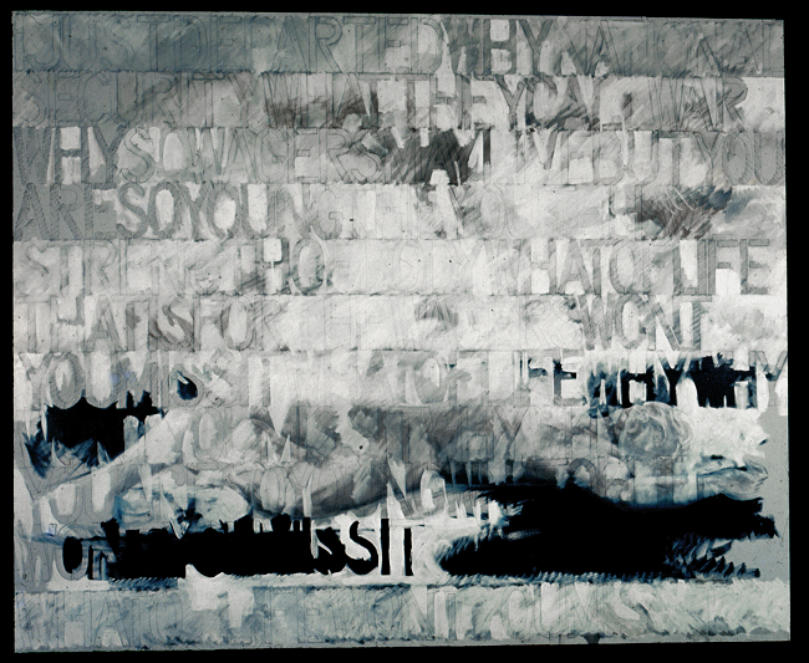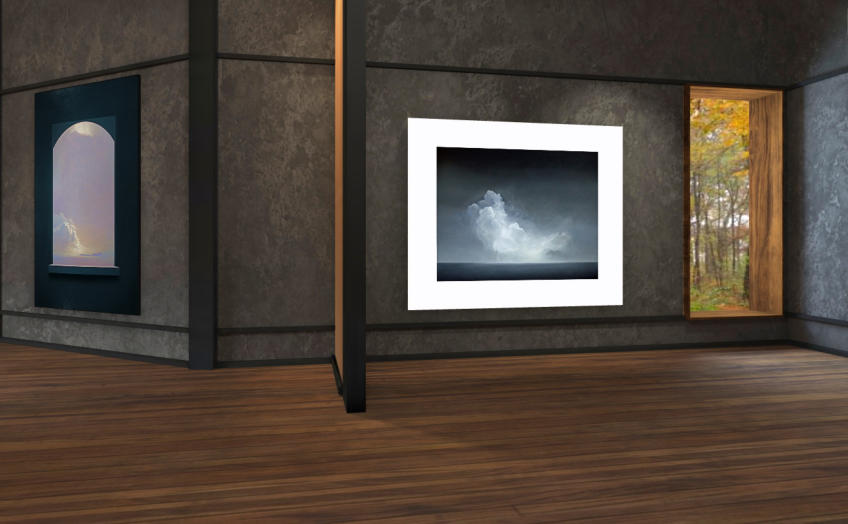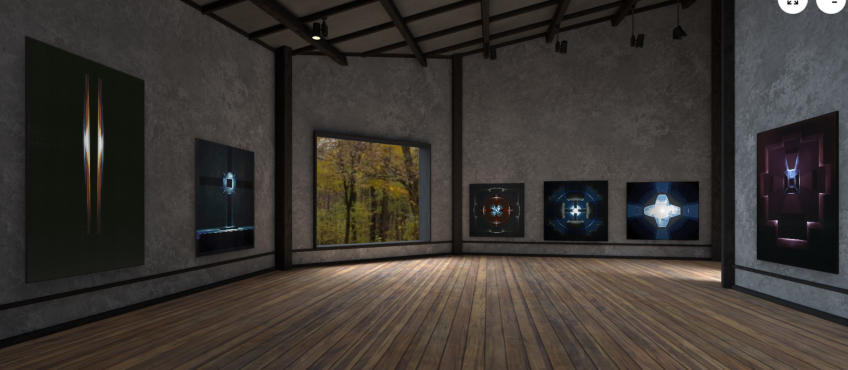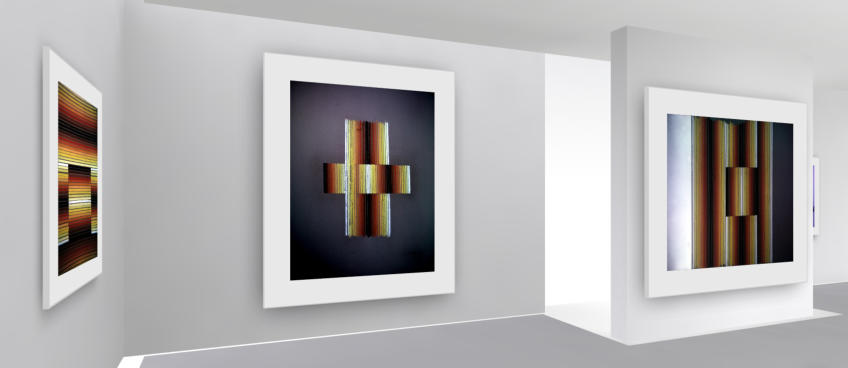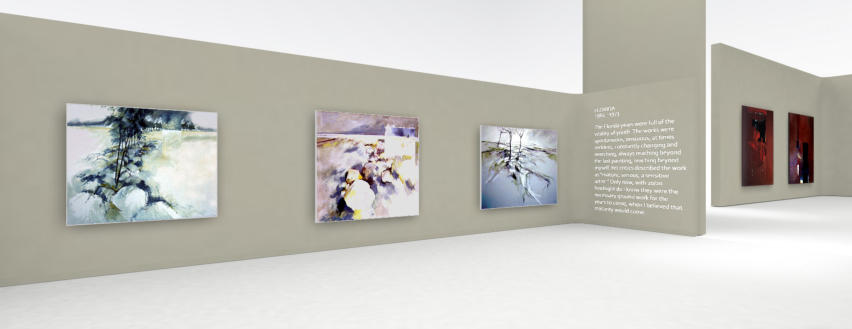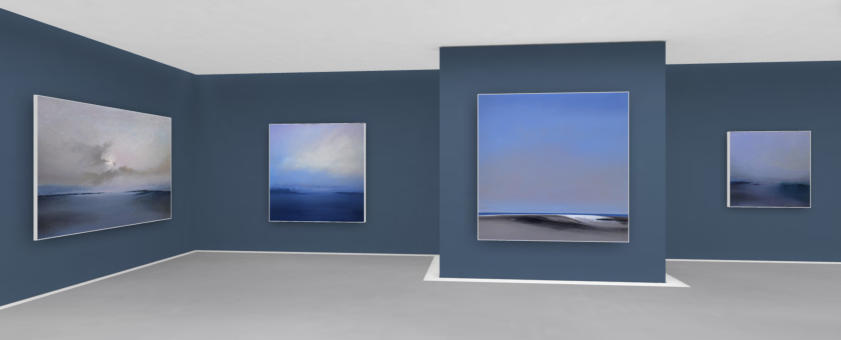Gradient Projects, a contemporary art gallery in Thomas, West Virginia
In the early 1980s, I had the good fortune of meeting and developing
a close relationship with Dr. Elisabeth Kübler-Ross that lasted over a
decade. Dr. Ross honored me with an invitation to serve on the Board of
Directors for the International Elisabeth Kübler-Ross Center in Head
Waters, Virginia.
Over the ten years I knew Elisabeth, we became good friends, spending
countless hours discussing her philosophies and teachings about death
and dying. Dr. Kübler-Ross entered my life at a pivotal moment,
awakening me to self-love. This newfound strength and insight enabled
me to help others discover their own source of infinite love and find peace
as they transitioned into the everlasting Light of unconditional Love.
Some might call my meeting with Dr. Elisabeth Kübler-Ross a chance
encounter, but I disagree. As AIDS was on the brink of becoming an
epidemic, Elisabeth emerged as a leader in the fight against ignorance and
prejudice. As she often said, "There is no such thing as coincidence." I
wholeheartedly believe our paths crossed as part of a sacred dance
choreographed long before we knew each other's names.
"MEMENTO MORI "
PAINTINGS BY ROBERT SINGLETON
12|21|2024 to 03|31|2025
Dr. Elisabeth Kübler-Ross
The Latin quote "Memento Mori " means "remember (that you have) to die."
It is a common motif in art and reminds us of the inevitability of death.
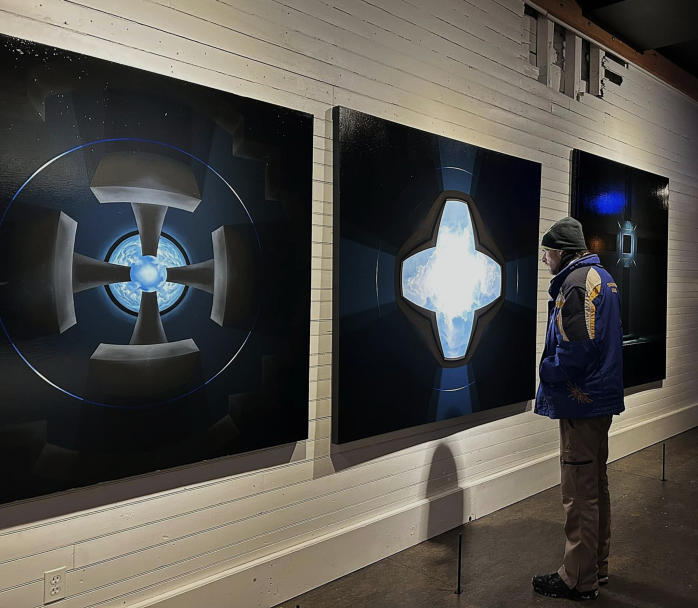
Dr. Ross brought death and dying out of the closet, laid the
foundation for the worldwide Hospice movement, and, perhaps most
importantly, deepened our understanding of Unconditional Love.
Vision III - Leaving The Body - Oil on Canvas 1978 - 68” X 80”
Gradient Projects, a contemporary art gallery in Thomas, West Virginia
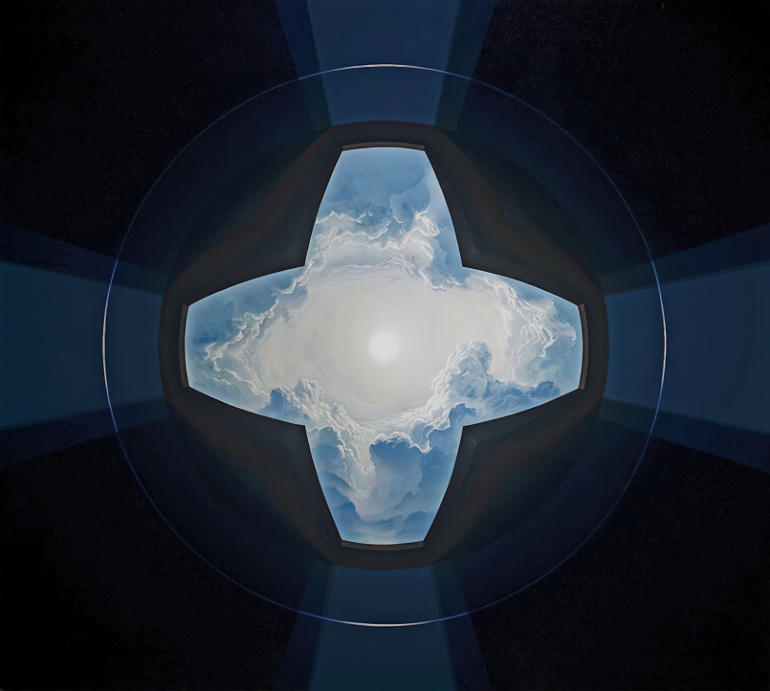
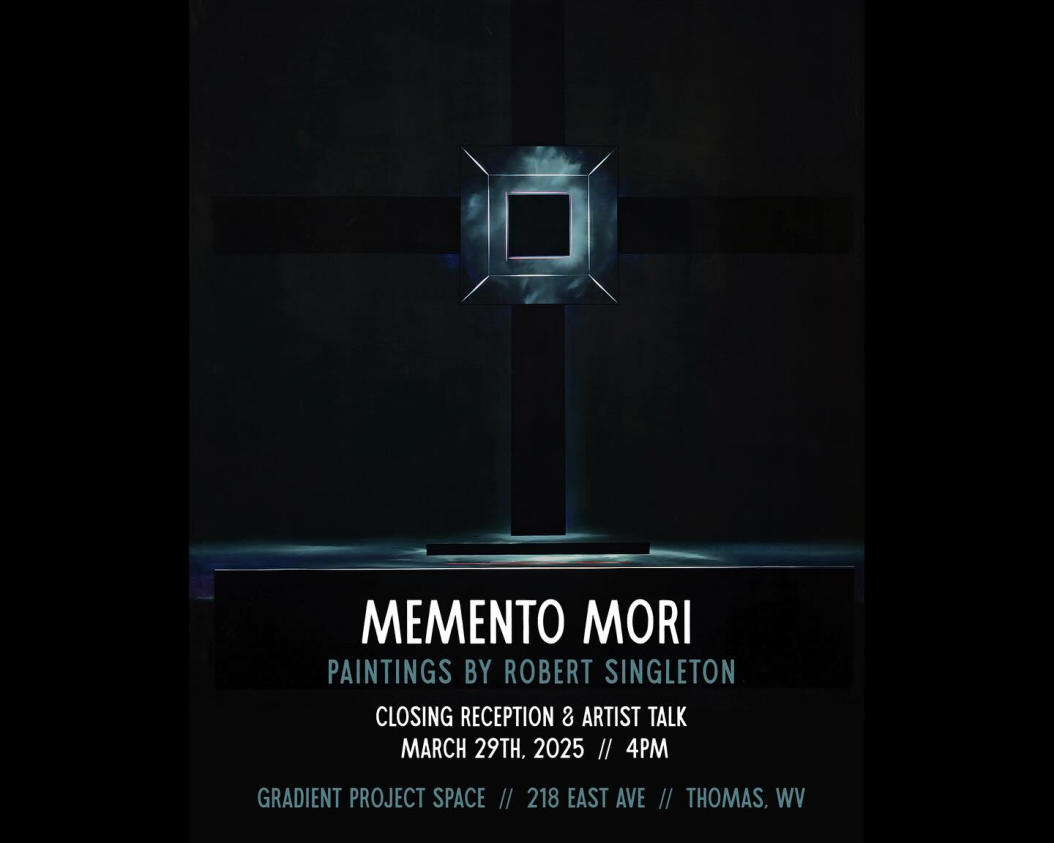
The Works of Robert Singleton
Virtual Galleries
These galleries are best viewed with full screen on a Mac, PC or Tablet
West Virginia 2012 | 2024
West Virginia 1978 | 2012

Screamer Mountain – 1973 ~ 1978
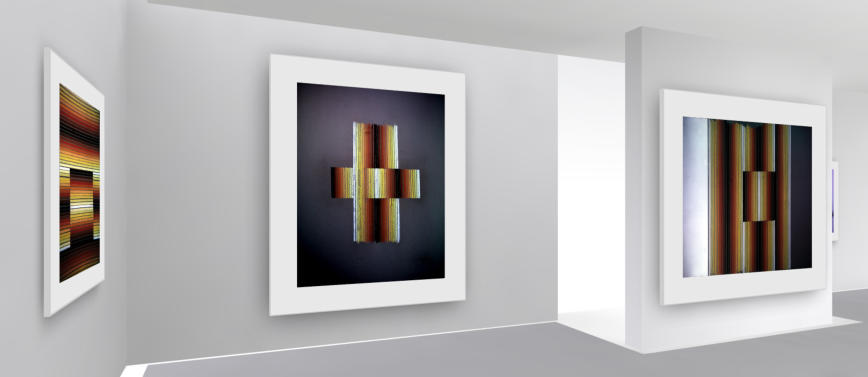
Screamer Mountain – 1973 ~ 1978
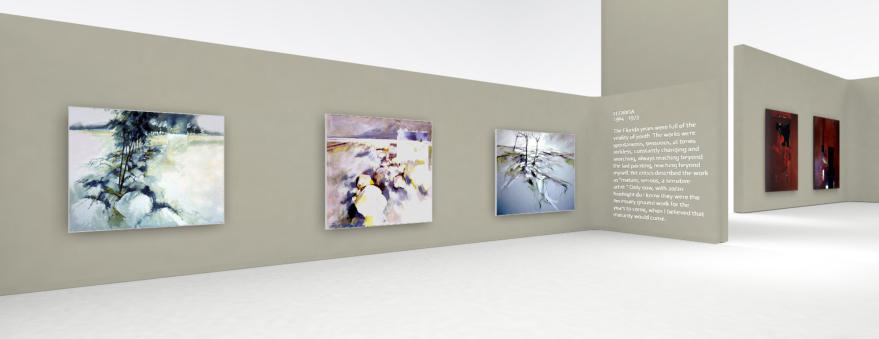
Florida - 1963 ~ 1974
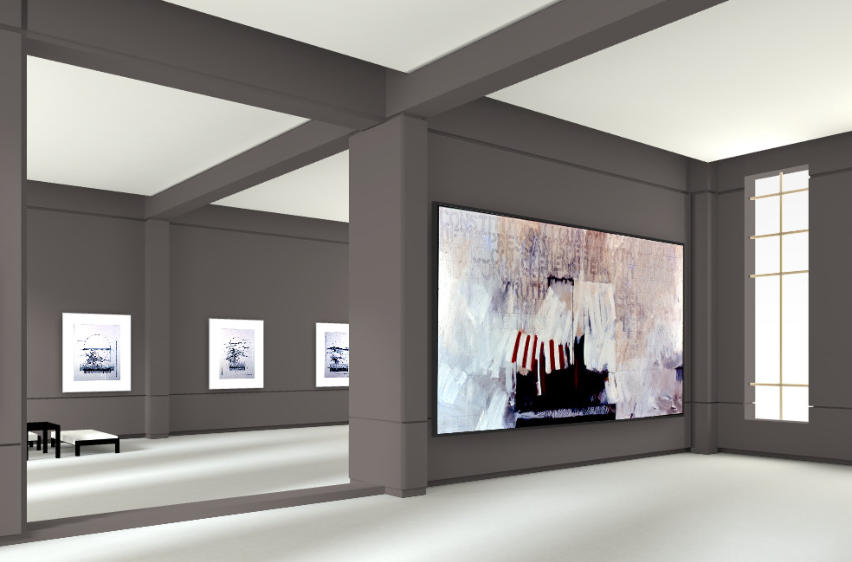
Florida - 1963 ~ 1974
Ambient Music by Dan Morro










The Adventures of Pearl
Graphics

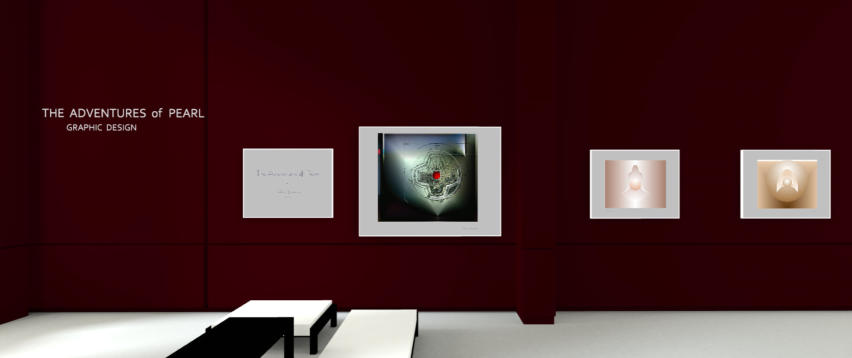
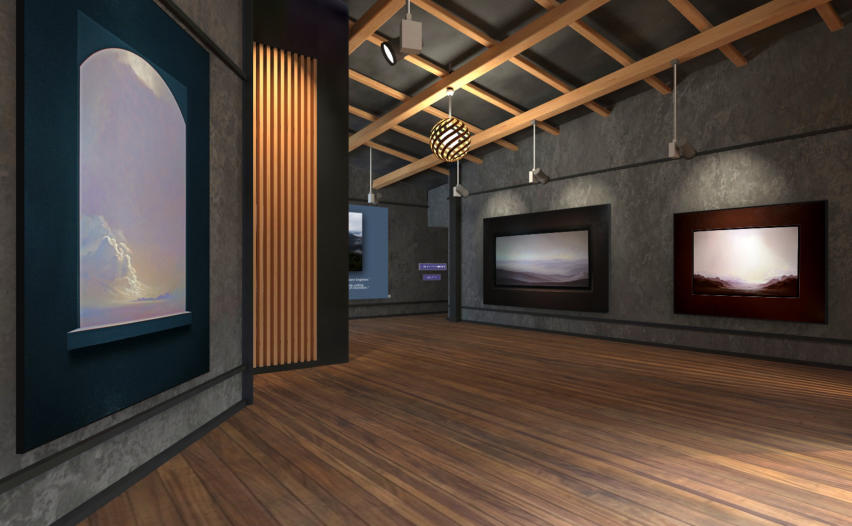
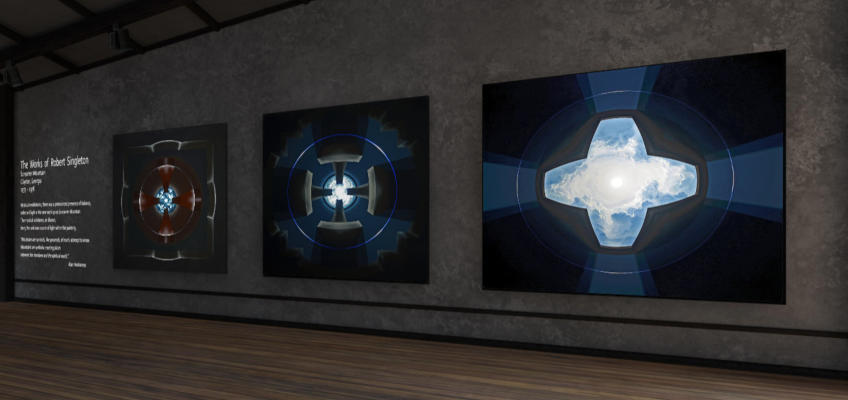




Life's Connected Events . . .
Now,
that
I
am
in
my
87th
year,
I
can
only
look
at
my
previous
work
as
a
preamble.
I
work
daily,
exploring,
discovering
new
inspirations
for
new
images.
Knowing
the
vastness
of
the
unknown becomes ever clearer.
The
lifelong
story
of
my
artistic
approach
is
to
question
creativity
itself
and
where
it
comes
from.
Is
it
really
about
the
artist/creator
as
the
author
of
metaphors;
the
biographer
of
illusions?
Or,
is
it
more
about
life
and
the
influence
of
life's
connected
events
which result in the measured evolution of the imaginative act?
In
the
mid-1950's
I
studied
painting
under
a
professor
who
was
a
disciple
of
Hans
Hoffman.
In
the
sixty
some
years
since,
my
art
has
passed
through
many
transformations.
In
the
same
way
I,
as
a
person,
have
evolved.
Life
and
Art,
the
two
are
still
analogous
paths; side by side, my work has always reflected these many passages.
One
of
the
journeys
of
great
impact
in
my
artistic
development
took
place
in
1960.
As
a
young
adult,
I
traveled
across
the
United
States
and
saw
for
the
first
time
the
great
expanse of the plains of the Midwest.
Visually
what
I
experienced
was
profound.
The
Horizon
Line.
I
wrote
in
my
sketchbook,
"You
can
turn
360
degrees
and
see
nothing.”
From
Kansas
on,
this
line
spellbound
me.
A
line
that
was
the
division
between
sky
and
the
wide-open
prairie;
uncluttered space, empty space with this hard, crisp line intersecting.
Continue to Next Page
Robert Singleton
is a renowned American artist whose work primarily
focuses on capturing the essence of the sky, clouds, and horizon lines.
Singleton's paintings are imbued with more profound philosophical and
emotional resonances. His art explores the liminal spaces between opposites,
inviting viewers to contemplate the complexities and interconnectedness of
existence. The recurring motifs of clouds and horizons serve as metaphors
for the transient nature of life and the ever-shifting boundaries between
different states of being.



As
a
child,
on
many
levels,
I
was
accustomed
to
loneliness.
Visually,
what
I
witnessed
translated
to
deep
emotions.
I
saw
what
I
as
a
child
had
felt.
I
found
in
the
natural
world
a
human
emotion.
In
the
years
to
come,
this
emotion
would
translate
into
images
of
empty
space
divided
by
a
single
horizontal
line.
The
tie
between
the
visual
and
the
emotional
self
would merge.
Creativity
has
been
a
voice
expressing
a
deep
personal
desire
to
speak
of
the
broad
spectrum of human emotions. Our state of existence . . .
The
creative
process,
as
often
as
not,
is
cluttered
with
human
frailties.
Still,
art
is
a
subjective
manifestation
of
those
frailties,
an
expression
of
both
the
pain
and
the
joy
of
life.
The pain of the internal search and the joy of the found.... expressed!
The
one
absolute
truth
of
my
life
has
been
my
art,
a
visual
communication
of
poetic
perception,
a
reflective
state
of
an
authentic
search.
At
a
given
moment
in
time
that
creative
expression
becomes
a
composite
of
the
entirety
of
this
person’s
being
.
.
.
bringing
all
the
creator is to that discipline.
In
the
mid-1970s
looking
up
towards
the
sky
my
imagination
was
captured
again,
this
time
by
clouds.
Images
we
often
take
for
granted,
seen
every
day;
above
the
horizon
line
filled with abstract forms of light and atmosphere, the ever-changing poetry of clouds.
Creation
is
often
described
as
a
movement
from
an
eternal
unformed
and
unchanging
dark
chaos.
Sky
and
earth
lie
together
in
a
changeless
embrace
until
forced
apart
by
their
offspring,
who
drive
a
wedge
between
them
producing
light
and
movement.
My
paintings
explore
these
creation
dynamics.
Why
did
our
early
ancestors
pick
the
meeting
of
sky
and
earth as a creative beginning?
Each
of
my
later
paintings
is
a
creation
whose
subject
is
creation.
Sky
and
earth
are
usually
male
and
female
in
myth
and
from
this
polarity
all
other
things
derive.
Without
polar
tensions
there
is
no
motion
and
no
story.
Thus,
the
sky
and
sea/earth
are
always
divided
by
a
horizon-wedge
keeping
them
in
tension
and
producing
clouds,
which,
in
their
movement
and
reflection
of
light,
bring
temporality
and
process.
Nothing
changes
more
quickly
than
clouds,
whose
shape
and
color
can
announce
brutal
violence
or
reflect
glorious
spectacular light through which our consciousness seeks to gain unity with nature.
While
every
work
of
art
has
to
achieve
a
balance
of
the
tension
or
forces
that
motivated
it,
my
paintings
include
a
sense
of
imminent
future
which
is
full
of
potentialities.
Most
of
my
clouds
announce
better
and
maybe
greater
events
are
about
to
happen. The paintings reveal the "world" of our moment in a more relevant way.
Why continue this quest? The answer is not complicated. My art is my Life.
Creatively
I
see
the
future
of
my
work/life
as
a
continuation
of
providing
a
means
of
uncovering
the
core
of
our
collective
evolutionary
message;
our
intuitive
understanding
and
cumulative
experience
ingrained
and
transmitted
through
generations
since
the
dawn of time. Creativity is the search for our shared universal awareness.
R e s o u r c e s
•
The Art of Living: 60 Propositions on Becoming
•
The Cloud Painter and the Berlin Musician
•
Until I Become Light
Award winning film documentary aired on PBS
2002 Produced by Real Earth Productions
•
West Virginia Public Broadcasting | By Kyle Vass
Published September 1, 2021 at 12:01 PM EDT
A Matter of Conscience
GENESIS: Excerpt from book, Core of My Joy
HOUSE IN THE CLOUDS: The Artistic Life of Robert Singleton
The 50-Year Artistic Journey
GUEST BOOK
BACK TO GALLERIES
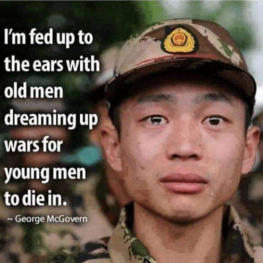

“War is a place where young people who don’t know each other, and don’t hate each other, kill each
other, by the decision of older rulers who know each other and hate each other, but don’t kill each
other…”
Erich Hartmann: German fighter pilot during World War II.
~
*
March 24, 2022: I saw this picture in the news. It collided with me at the core. Bring back images from the distant past.
*
1969 Vietnam
2022 Ukraine
Next Page
February 19, 2025: As I write this, history is fated to repeat itself. In 1969, the Vietnam War was taking
the lives of thousands. While the current global situation does share some similarities with 1968,
particularly in terms of ongoing conflicts and loss of life, it would be an oversimplification to say
we are headed back to that exact scenario. The world has evolved significantly regarding geopolitics,
technology, and global interconnectedness
.
However, the concerns about the human cost of conflict remain as relevant today as they were in 1968.
Casualties of Wars
Romance on Canvas
By Grace Kehrer
Spring 1969
Robert Singleton as an artist stands in the shadows of Romantic, realistic and transcendental
movements where notions like Nature, Man, Society, Individualism and Responsibility are strained
though the reality of two world wars, police actions, a crass materialism and an intensifying
depersonalization. Finding himself caught up in a miasmic atmosphere created, in part, by computer,
"Wagers" and a relativistic viewpoint, Singleton, the self-admitted incurable romantic, attempts to
understand a sick society and bring intelligible order to a chaotic universe.
Singleton's paintings on oversize canvases, done in primary colors, stand testimonial to contemporary
styling techniques executed under the banner of "Art for Art's sake." However, the questions, often
spelled out in block letters, are timeless and universal. While Singleton does not offer a solution to the
problem of man's inhumanity to man, nor locate a center of human spirituality, he does examine the
phenomena, continuing the quest in a personal, thoughtful and sensitive manner.


The second painting develops the idea of journalistic responsibility and influence. Interjecting often ignored,
possibly forgotten notions of equality, ethics, freedom and unbiased news, printed upon a white field
surrounding a patriotically colored centre, one can only hope these subtleties are not lost on the Sentinel staff.
Journalistic Responsibility – 1967 – 78” X 120” ~ Commissioned by the Orlando Sentinel
Singleton's latest work, one produced after much thought, recognizes the reality of the generation gap.
A literary message, in dialogue form over the figure of a dying boy, it exposes the inarticulate nature of
questions, the naivete of answers and the pain suffered by men separated by chronological age and
appetite.
Text as it appearers in painting
IJUSTDEPARTEDWHYNATIONAL
SECURITYWHATTHEYCALLWAR
WHYSOWAGERSMAYLIVEBUTYOU
ARESOYOUNGTHEYOUTHHAVETHE
STRENGTHOFBODYWHATOSLIFE
THATISFORTHEWAGERSWONT
YOUMISSITWHATOFLIFEWHY
WHATOFLIFEWHYWONTYOU
MISSITWHYWHYWHYWHY
Legible
"I just departed." "Why'?" "National
Security; what they call war."
"Why?" "So wagers may live" "But you
are so young" "The youth have the
strength of body" "What of life?"
"That is for the wagers." "Won’t
you miss It?" "What of life?''
"Why?" "Won't you miss it?"
"Why?" "What of life?''

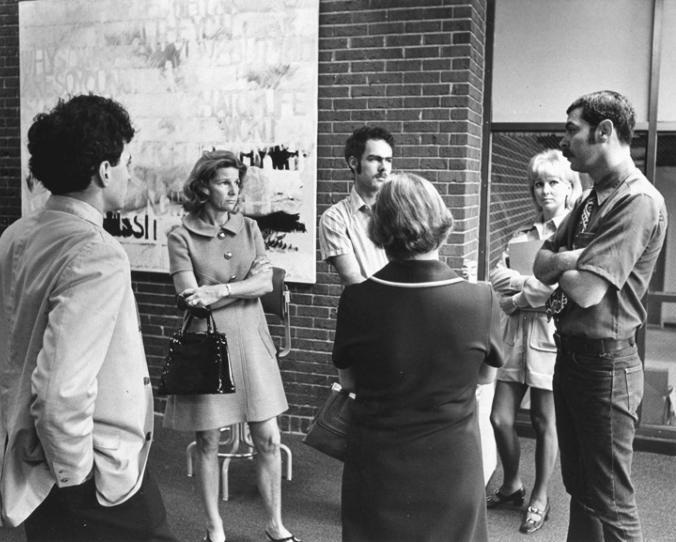


1969 Florida State University
– With WHY? hanging the background; students discussing the responsibility of artist according
to what they believe is morally right, to document their time, to protest, to reflect through their work the contemporary
violent values of humanity and the world. Be it visual arts, literature or music.
GENESIS: Excerpt from book, Core of My Joy
FLORIDA 1965 - 1973
I returned to Orlando, Florida, and my position with Jordan Marsh. I was good at
my work and they were happy to have me back. I found an apartment in Winter
Park, a community near Orlando.
Because of my skills as an artist, the director of the display department soon put
this ability to use. The men and women’s fashion windows were changed
monthly. Each of these display windows had 8 foot by 18 -foot background panel.
Each time, I would paint a thematic scene on ten of these panels.
These display windows became quite popular, as each of the background panels
were original painting. Over a period of time, they were saved and reused. It was
not fine art, but I was working and very happy with my $50.00 a week salary.
Several months after my return, I discovered a small cottage for rent north of
Orlando, in the tiny community of Altamonte Springs. This cottage was perfect,
located on an acre of land, surrounded by great spreading oak trees. The owner
told me no one had lived in it for a number of years. If I chose to rent the cottage,
it would be on an as-is basis, for $50.00 a month. It had so much character, built
of old brick, with a very large fireplace and screened-in porch on the back, a real
fixer-upper. I saw all kinds of potential and happily agreed to rent the cottage.
Within the first year, I cleaned, painted, landscaped, and furnished it. This
wonderful little house was more than a place to live. It gave me a sense of
stability and roots. It was my home. As a result, I was stable, working, and paying
the bills. My life was on an even keel. The fates were indeed being good to me.
Except, there was one thing missing. I was not painting. I had not put brush to
canvas since I left St. Augustine, the year before.
It seems the fates had other plans for me. I became physically ill, a full-blown
case of mononucleosis. I could not go to work. The doctor instructed me to have
lots of bed rest, and at work, they thought I might be contagious. Weeks went by
as I began to improve. I was bored. In order to help pass the time, I pulled out my
paint box and on the back porch, began to paint. There was no pressure. I even
wondered if I still had that creative drive. Well, I did paint again. Within a short
time, I had produced five or six canvases. Most were my remembrances /
impressions of Conk Island and the dunes.
As a result of not being able to return to work at Jordan Marsh, my cash flow was
running short. Coincidentally, I had been told that in a few days there was going
to be an art show/competition held just a few blocks away from my home at a
small shopping mall. This clothes line art show was open to anyone who showed
up.
I had never submitted my work to a competition or ever entered an art show of
this nature. I just thought maybe peddling a painting or two would help the
financial situation.
I strung a heavy wire between two poles and hung the paintings like hanging out
the wash. All I had to do was sit and wait; hopefully someone would purchase a
painting. I did wander around looking at all the other artists’ works that were on
display.
My paintings by comparison, appeared to be very different, almost abstract to the
very realistic work of the other artists. I thought, “I must have an odd way of
painting, of seeing my visual world.” I did not feel encouraged. There were lots of
lookers, but none were interested in purchasing my work. By afternoon, the
judging was to take place. There were three awards, with a blue ribbon and a gold
pin for best in show. I won! --- A painting entitled “Dunes I” won Best in
Show. There was much excitement as all the other artists came over to
congratulate me.
The next day I sold a painting for $30.00. In addition, a number of the artists
present told me there were many sidewalk art shows of this nature all over the
east coast of Florida, almost one or two monthly. They persuaded me to enter
these other shows. And so, I did. The following weekend at the Daytona Beach
sidewalk art festival, I sold three paintings.
The next weekend at the New Smyrna Beach sidewalk art festival, “Dunes
II” won first prize, another blue ribbon and one hundred dollars cash.
I found myself faced with having to make a decision that could potentially affect
the rest of my life. I was now well enough to return to the stability and security of
a $50.00 dollar a week paycheck. “Don’t rock the boat. You are stable and doing
just fine with your job at Jordan Marsh. Your painting should be just a hobby. Be a
Sunday painter.
Would it be an irresponsible act on my part to quit my job and become a full-time
artist? Even now, as I describe that moment in time, I feel the anxiety, the
insecurity of not knowing. To follow the dictates of my heart and take a chance,
to invite the lack of security into my life.
The choice was made. A definition given, a commitment to explore beyond my
human boundaries, to take chances, to become vulnerable. In time this choice
would be the instrument that would lead to exposing the very image of my soul.
My identity was found both internally and externally. It was a beginning, a fresh
start in life.
From April 19, 1965, when my painting won that first award, my art career
escalated at a rate almost beyond belief. These sidewalk art shows were for many
aspiring artists, an important means to have one’s artwork exposed to the public,
museum curators and commercial gallery owners. Gallery owners used these art
shows as a means to find artists, who they would in turn invite to become
members of their galleries stable of artists.
On June 17, 1966, just three short months after winning that initial award, the
first public showing of my work through a commercial gallery opened. Webb
Gallery was a new and provocative gallery handling all the major artists from the
entire state of Florida. This one-person show was the first significant endorsement
of the work. For me a validation of its worthiness. In all honesty I was humbled
and honored to have my work hanging with such an auspicious stable of
artists. The exhibition was even reviewed by the art critic with the Orlando
Sentinel. With the headline, “He’s best when he’s different. July 10th, 1966,
another one-person show opened with another gallery, this exhibition established
the begin of an association with the Salty Dag Art Gallery in Cocoa Beach and its
owner, Kit Young. Kit became a close personal friend and in time became my
agent. From the very beginning she believed in my work and me, always
encouraging, coaxing and advocating both professionally and personally. If I were
to credit one person for nourishing the establishment of my career, it is Kit. Kit
came to my studio once a month. I would show her all the new works.
She would make a number of selections, take the new paintings back to her
gallery and immediately put them on display. There seemed to be an enormous
interest in my work growing in the Cape Canaveral space coast region. Generally,
by her next visit, all the paintings she had picked up the previous month had been
sold. After several of these visits, Kit suggested that she would be willing to
purchase all the monthly works from me outright. What this did mean for me? I
did not have to wait for the works to be sold before I would be paid; it became
the security of a steady monthly income. November 5th, 1966, encouraged by Kit,
I entered one of the major art shows for the state of Florida, the Cocoa Beach Art
Festival. One of the paintings entitled “Evolution” won first prize.
The list of shows and awards would grow. In just four years, my works won 22
major awards, including 12 best of shows. In just one show, the 1968 Daytona
Beach Art Festival, the work won two first-place, a second, Judges Choice and two
honorable mentions. Every painting I had on display won an award.
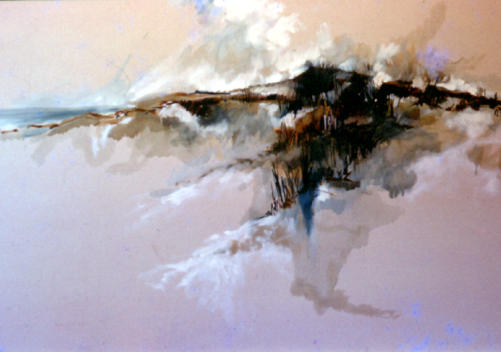
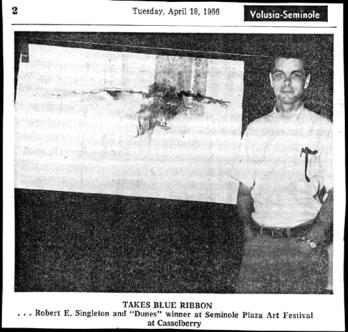
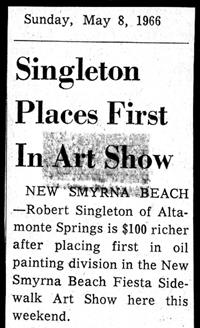
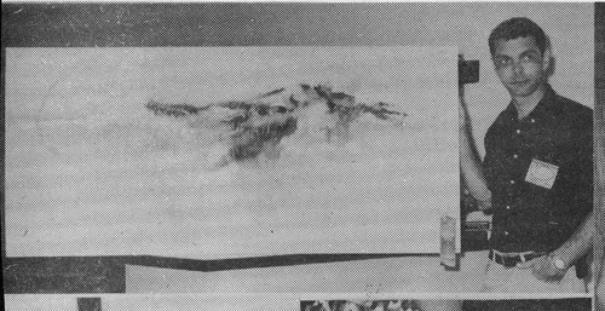
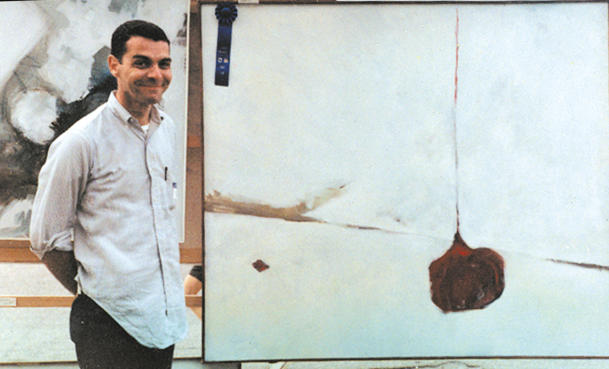
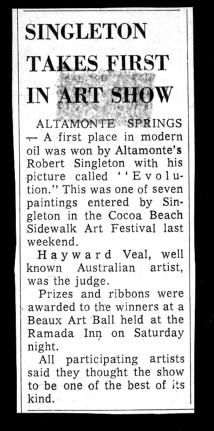
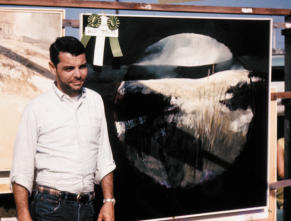

The judges for these art shows were exemplary. They ranged from nationally
recognized museum directors to curators and critics. Including Dr. Lester Cook, [at
the time the curator of American painting at the Smithsonian Institutes’ National
Gallery of Art in Washington, D.C.]. On three separate occasions Dr. Cook gave
my work the highest award. Apparently, Dr. Cook felt the work was strong. “I am
very impressed with Robert Singleton’s work. He is obviously a mature, serious,
and a sensitive artist.” Dr. Cook also wanted to help further my career by making
a number of opportunities available to me. On one occasion, on behalf of the
United States State Department, he invited me to go to Vietnam as an artist war
correspondent. I thanked him for the offer, but refused.
Winning all these awards was certainly a boost for my self-esteem. However,
what were most significant were the caliber of the judges and their endorsement
of my work by selecting it for the top awards. Listed below a few of the judge’s
statements which appeared either in the press or in personal letters to me:
James Johnson Sweeney, former director, Guggenheim Museum, Museum of
Modern Art, and The Houston Museum of Fine Arts. “Knowledgeable, competent
and sensitive, also extremely assured in its handling.”
Dr. David W. Scott, Director of Fine Arts of the Smithsonian Institute, Washington,
D.C. “I was impressed by his breadth and largeness of concept, and by the
combination of control and vigor. The works conveying a sense of authority, which
made them outstanding.”
August C. Freundlich, Director, Joe and Emily Lowe Art Gallery, University of
Miami, Miami Florida. “I personally find his work fresh and exciting, and worthy of
serious consideration. I look forward to hearing more from this artist.”
Bartlett H. Hayes, Jr., former Director, Addison Gallery of American Art. “I find in
his work, an abstract feeling for nature itself as we understand it in our present
century. Its quality seems so obvious that it hardly needs words to fortify it.”
Cleve K. Scarborough, Director, Mint Museum of Art. “Mr. Robert Singleton
recently had three prints accepted into the Mint Museum’s annual Piedmont
Graphics Competition. Two of the prints received purchase awards. The prints
were extremely unique, especially in technique. The subtle modulation of the ink
on the metallic-like surface was a most unusual effect. The abstract forms seemed
to float without the existence of a ground. We were very anxious to have one of
Mr. Singleton’s prints in our permanent collection.”
As my work became more widely known, it seemed opportunities were coming at
me right and left. I was deeply flattered, but many I could not accept. For
example, the Dean of the Art School of the University of Hawaii invited me, with
all expenses paid plus salary, to the University campus as Artist in Residence for
an indefinite period. NASA, along with a number of nationally known artists,
invited me to come to Cape Kennedy to witness the launches of the Apollo moon
missions. Though I did not attend I did witness the Apollo 17-night launch by the
invitation of the Mayor of Orlando as part of Vice President Spiro Agnew’s party.
I was nominated and awarded a Ford Foundation Grant to attend the Tamarind
Institute in Albuquerque, New Mexico. Tamarind had been established to
encourage or assist recognized artists in the creation of lithographs.
In March of 1967, and the two following years, I entered my work in perhaps the
largest and most prestigious art show in the Southeastern United States, the
Winter Park Sidewalk Art Festival, Winter Park, Florida. This show represented
five to six hundred, preselected, artists from the entire country. Over a period of
three days, three hundred thousand of the art-loving public would attend this
show. In 1967, a painting entitled “Double Entendre” won the First and Second
awards in painting. This special award resulted from the two judges refusing to
concede on their choice for First Place. As a compromise, First and Second Place
was combined, this was split between another artist and myself.
As with many artists, I began to explore other creative mediums of expression. In
my case, I started working in sculpture and printmaking. In 1968, at the Winter
Park show, I won best of show in graphics. In 1969, I won best of show in
sculpture.
I recall jokingly saying I had a Michelangelo syndrome. I was being recognized for
sculpture and print making, when my passion was in my painting. Michelangelo’s
passion was sculpture, but he was forced to make a living painting ceilings.
Suddenly, there was always food on the table. As Kit would say, metaphorically, “I
went from flour pancakes to smoked oysters.” This was such a long way from
painting in that room in the Seattle YMCA, a long way from that starving artist
eating peanuts and Coca-Colas and hustling his wares in bars.
It is time to slow down and backtrack. My career had taken off like a rocket. Also,
within that first year, 1966, I started teaching with the Lock Haven Art
Center. Within just a few years, I was teaching almost full time, as many as three,
three-hour studio classes daily. Teaching beginning drawing, painting to master
critique classes. There was always a waiting list of students wanting to attend
these classes. Sometime in the early 70’s when the art center went through a
significant remodeling and expansion, the Lock Haven Art Center became the
Orlando Museum of Fine Arts, a major museum and art school.
One of my other skills was happily put to use, that of exhibit designer. On the
occasion of the gala grand opening of the new museum, I designed and installed
all the new exhibitions. I continued to design and install all the major exhibitions
throughout my tenure with the museum.
Fortunately, adjacent to my little cottage was a small two-room building. A retired
doctor had constructed this building as a woodworking hobby shop. As the doctor
became too old to pursue his hobby, all the tools were sold and the building
emptied. This was the state in which I found it, when I first rented my home. I
contacted the doctor’s wife and she agreed to let me rent the building. My first
studio! What a luxury, a space devoted exclusively to my work. I later purchased
this building and created, between the cottage and studio, a walled-in courtyard.
What was I producing in this studio? I was very prolific. Every single image created
on either canvas or paper originated from my imagination. On very few occasions
have I used my photography as a reference. The subject matter of these early
paintings was almost exclusively of nature and my memory of it, that is, in generic
terms, land and seascapes. The specific images were my many remembered
impressions of Conk Island and of course of that Midwest horizon line. As in
music many times the works were themes and variations. I now feel it was not
just that I was so prolific, but foremost, I was constantly searching, pushing and
exploring my creating boundaries, always reaching beyond, growing beyond the
previous painting.
From 1966 to 1970, through this constant searching, the work passed through a
major metamorphosis. It was a transformation from impressionistic studies of
nature to very large canvases which were totally nonobjective (no recognizable
subject)
At the end of 1970 I made an important decision, I stopped entering all art
competitions, side walk art shows etc. This decision was based on competitive
presser. I, my work, had an unbroken record of winning the top awards. It was
uncanny what happened. Because of my “perfect score,” I was told, that when a
number of artists made application to enter these competitions, they would want
to know if “Singleton” was going to be in the show. If the answer were to the
affirmative, they would say, “Why bother?” and not enter. This both embarrassed
me and put more undue pressure on me. There was a second reason, which I
recall expressing the following way, “It was like being the fastest gun in the west
sooner or later someone was going to shoot me down.” And so, I quit while I was
ahead. As soon as the word circulated around that I was no longer participating
and competing, I was invited back as a juror.
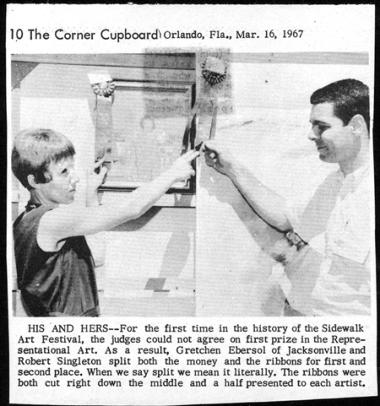
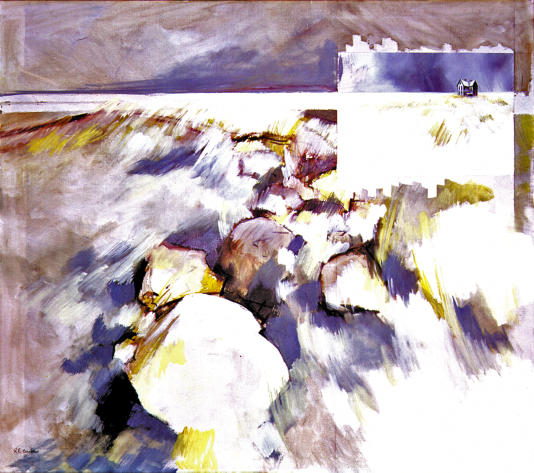
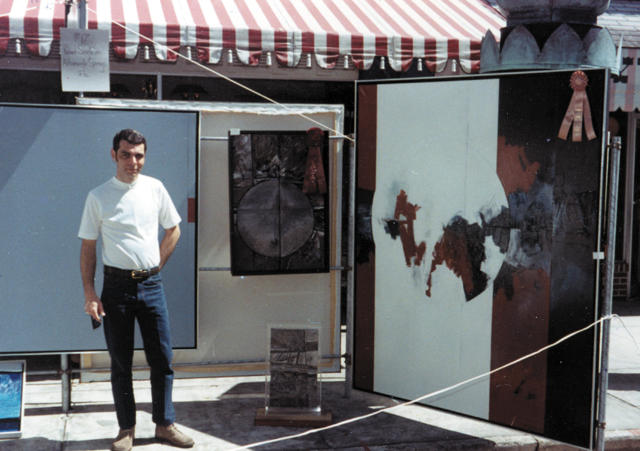


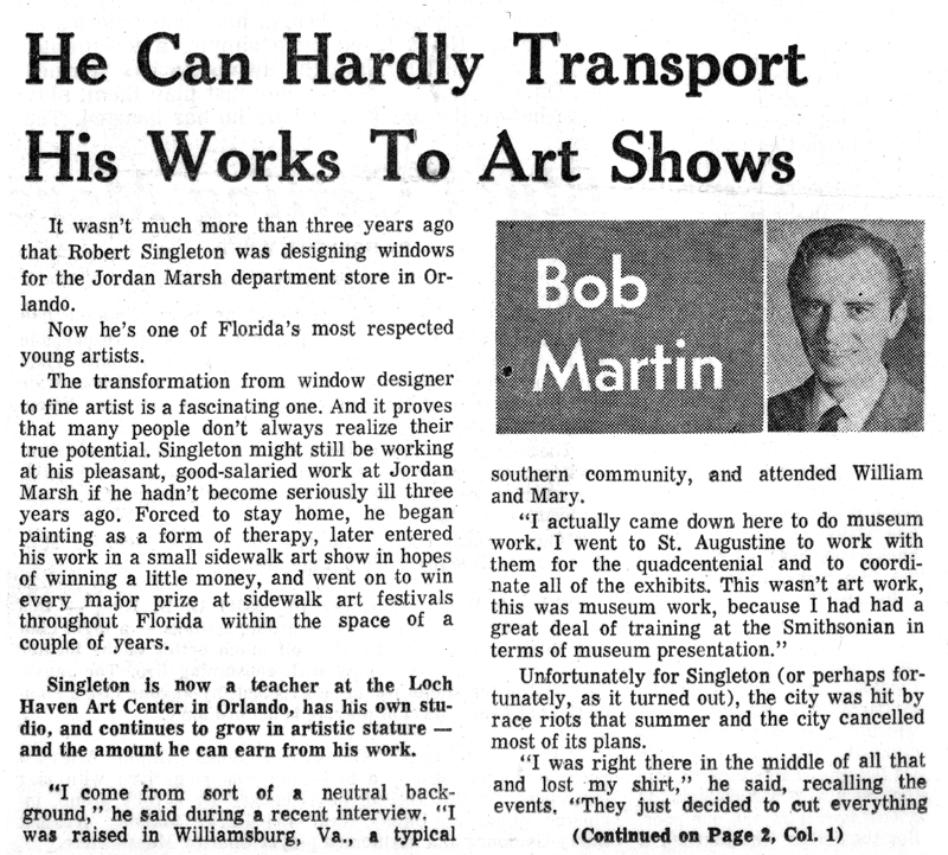
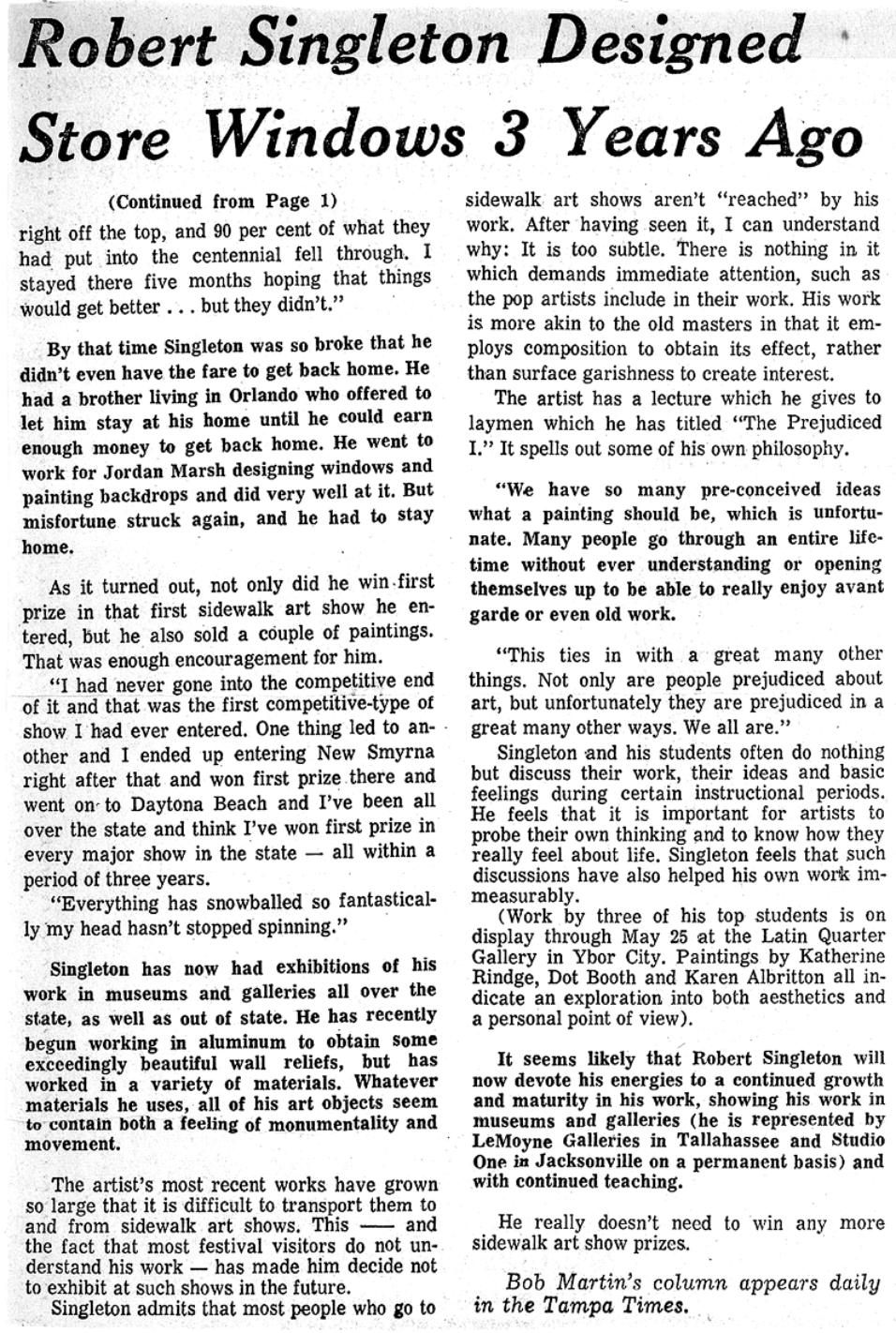
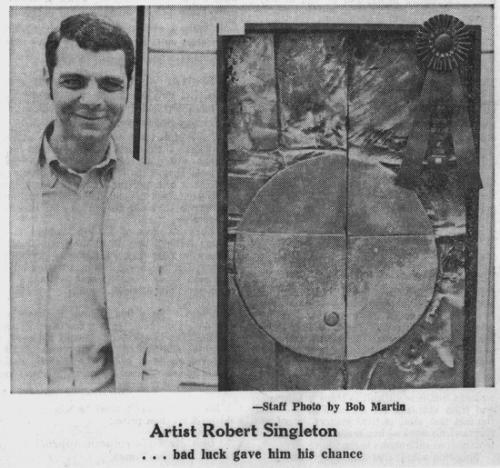

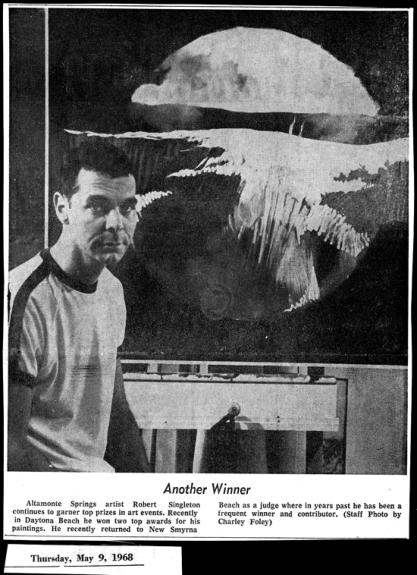
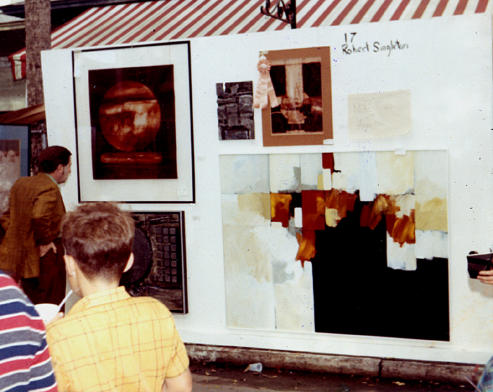






Awards – Honors
2021 -22 ~ Tamarack Foundation for the Arts, Master Artist Fellow, Lifetime
Achievement Award.
2018 ~ George Mason University
“Where it comes from: An exploration of human creativity”
Guest lecturer for the 2018 “Vernon and Marguerite Gras Lecture in the Humanities.”
1986 ~ Benefit Exhibition “Robert Singleton Weekend” –
Guest of honor at black tie dinner and exhibition of new works. Donated twenty-nine
works to raise funds for the Maitland Art Center’s building fund. The event rose over
$20,000 for the art center. Gallery talk and lecture at the Maitland Civic Center.
Maitland, Florida.
1985 - 1995 - Served on the Board of Directors of the Elisabeth Kubler-Ross
Center.
1977 ~ Endorsement of influential art dealer / artist agent Leo Castelli.
1970, 71, 73 MacDowell Fallow Grant, MacDowell Colony, Peterborough, New
Hampshire.
1973 ~ Received invitation to be Visiting Artist and Instructor – University of Hawaii –
(Did not accept)
1970 - 1971 ~ Piedmont Graphics Competition Mint Museum, Charlotte, North
Carolina, Juried group graphics show. Two purchase awards.
1970 ~ Ford Foundation Grant to attend Tamarind Institute,
College of Fine Arts at the University of New Mexico. (Did not attend)
1969 ~ Winter Park Sidewalk Art Festival, Best in Show, Sculpture, Award of Merit,
Painting – Winter Park, Florida.
1969 ~ Ocala Art Festival, Best in Show - Ocala, Florida.
1968 ~ Winter Park Sidewalk Art Festival, Best in Show Graphics, Winter Park,
Florida.
1968 ~ Daytona Beach Art Festival, First Place (oil painting), First Place (non-
objective)
Second Place (representation), Judge’s Choice (special award)
1967 ~ Florida Seaside Art Show, First place in painting. Indialantic, Florida.
1967 ~ Cocoa Beach Art Festival, Beat in Show in painting, Cocoa Beach, Florida.
1967 ~ M & C East Art Show, First Place in painting purchase award, Ocala, Florida.
1967 ~ Winter Park Sidewalk Art Festival, First and Second place in painting. Winter
Park, Florida.
1966 ~ Cocoa Beach Art Festival, First Place in painting, Cocoa Beach, Florida.









































